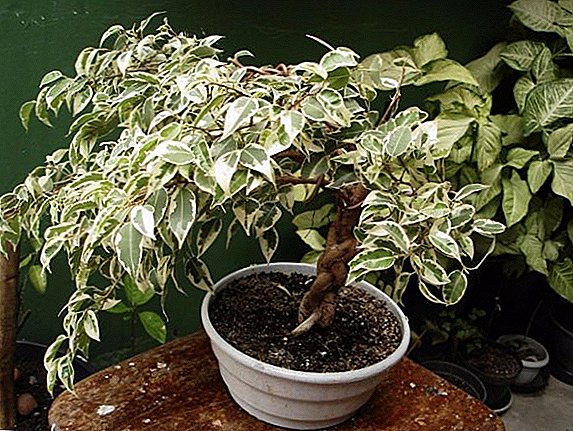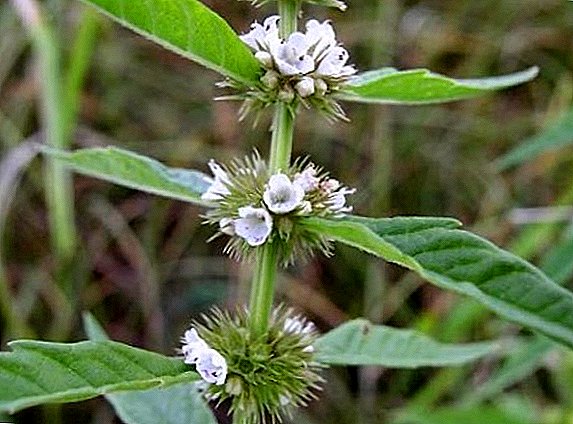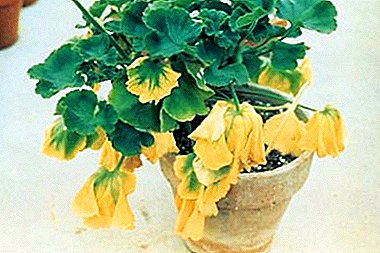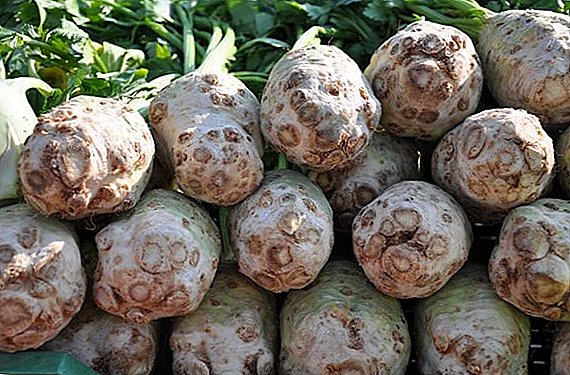 Growing root celery is not a difficult task, but it requires attention and approach. After all, it is very good to enjoy nutritious salads in the winter with root vegetables grown in their garden.
Growing root celery is not a difficult task, but it requires attention and approach. After all, it is very good to enjoy nutritious salads in the winter with root vegetables grown in their garden.
 Someone frightens off such a long time of ripening celery, someone does not want to give him their time. But it will be much more pleasant to wait for your harvest, realizing that it was not for nothing that forces were invested. Frequently asked questions: when to plant celery in open ground, how to water, what to feed?
Someone frightens off such a long time of ripening celery, someone does not want to give him their time. But it will be much more pleasant to wait for your harvest, realizing that it was not for nothing that forces were invested. Frequently asked questions: when to plant celery in open ground, how to water, what to feed?
Answers to them can be found in this article, and a novice gardener can easily understand all the intricacies of planting celery. It is possible that even an experienced gardener will discover something new.
Celery Root: Description
The homeland of celery is the Mediterranean. Now it is difficult to find a place on earth where a healthy vegetable does not grow. It is a plant up to 1 meter tall. In the first year of planting, a lot of leaves appear and the root itself, the following year, celery begins to bloom. The plant loves good moisture and easily tolerates frost.
Celery root is cultivated almost always in a seedling manner. The fruits of the plant contain many beneficial substances, such as sugar, protein, calcium, potassium, phosphorus. Also, celery is generous with vitamins A, B6, K, E, B9 and contains mineral salts of iron and magnesium.
 Absolutely all parts of the plant find a place in cooking: first and second courses, seasonings, sauces and even drinks. The root of the plant is recommended to use boiled, baked and as a supplement to salads - in its raw form. To cultivate celery can be easily.
Absolutely all parts of the plant find a place in cooking: first and second courses, seasonings, sauces and even drinks. The root of the plant is recommended to use boiled, baked and as a supplement to salads - in its raw form. To cultivate celery can be easily.
Did you know? In ancient mythology, the goddess Aphrodite ate celery roots, attributing to him the properties of eternal youth.
How to grow celery in the country: the choice of the site for the root
Most fans of this product sooner or later wonder how to grow root celery on your site. The first thing to start with is to choose a place to plant a plant.
Celery root prefers more windless places with open sunlight. Also needs fertile soil rich in minerals and with a certain acidity. But, as experience shows, a root crop can give an excellent harvest in a small penumbra on slightly acidic soil. The fruits will differ only slightly by smell.
What celery loves: light, temperature and humidity
Absolutely all celery varieties like high humidity, but within reason, without stagnant water. The plant is unpretentious to the temperature and can safely tolerate frosts, but during the growing season it is better to protect the celery from frost, otherwise, instead of a nutritious fruit, you will get an inedible root with abundantly growing leaves.
As mentioned above, the plant feels great both in the sun and in light penumbra.
Soil for growing celery
 The ground for celery growth must be prepared in autumn. It is important to make a deep digging, not forgetting to generously enrich the soil with superphosphate and humus. Also, the soil should be moderately acidic, otherwise at best celery will grow poorly.
The ground for celery growth must be prepared in autumn. It is important to make a deep digging, not forgetting to generously enrich the soil with superphosphate and humus. Also, the soil should be moderately acidic, otherwise at best celery will grow poorly.
There should be no stagnation of water in the ground, despite the fact that celery likes constant humidity. If you grow a root vegetable on clay soil, take care of good drainage. It will be good to add nitrogen and potassium in autumn. But avoid fertilizing the land with fresh manure, this can lead to fetal disease.
Important! In no case do not cut a lot of leaves in the summer, it can lead to a loss in the size of the root.
How to plant celery
How to plant root celery in your garden? In order to harvest the best possible crop, you first need to plant seeds for seedlings. This is because celery is very weak at the beginning of growth. The ripening period of the root itself ranges from 6 to 8 months.
First you need to choose good seeds, plant them, go to the first shoots, and then plant the seedlings in the garden.
Selection and preparation of seeds for planting
 Particular attention should be paid to the choice of seeds. In order to get the fruits of the next year, take the seeds with a shelf life. Also pay attention to their size. The larger the seed, the more the root crop will grow.
Particular attention should be paid to the choice of seeds. In order to get the fruits of the next year, take the seeds with a shelf life. Also pay attention to their size. The larger the seed, the more the root crop will grow.
Most farmers prefer foreign celery varieties, but there are positive reviews about domestic producers. For example, our most popular varieties are Russian size and Aelita. Because of our climate, it is recommended to choose earlier varieties that can ripen to six months.
Begin planting seedlings closer to the end of February. Take your chosen seeds and immerse them in warm water. This is needed to soften the seeds and their early germination. In the water, the seeds should stay no more than two days, after which they are slightly dried and ready for planting.
Did you know? Such a long growth of seedlings of celery root is due to the fact that the seed contains a huge amount of essential oil.
Celery sowing and seedling care
After the seeds are prepared, you can already plant them in a special soil. To cook it Take in equal proportions sand, peat, compost and humus. This composition is considered one of the best for growing celery seedlings.
When planting seeds do not immerse them too deep. After deepening the seed, sprinkle the hole and surface with peat. For seven days, the shoots will not yet appear, and for them it is necessary to withstand temperatures from 17 to 20 degrees. After you notice the first growth, you need to lower the temperature to 15 degrees.
 For the entire period of growth in the seedlings celery needs timely and responsible care. It is necessary to give a sufficient amount of light, to maintain the desired temperature and to be very careful with watering. These are important points in the process of how to grow good celery.
For the entire period of growth in the seedlings celery needs timely and responsible care. It is necessary to give a sufficient amount of light, to maintain the desired temperature and to be very careful with watering. These are important points in the process of how to grow good celery.
Important! If there is a risk of frost after disembarking, it is worth covering the sprouts with cut plastic bottles.
Pickling seedlings in open ground
When, finally, warm days come, without the risk of frost, you can plant celery seedlings in the ground. Usually this time falls on the third week of May. The soil should already be prepared in the fall. Celery should be planted with a distance of at least 30 cm from each other.
When deepening, it is advisable not to destroy the earthen room and not to immerse the root deep in the ground. Drain the well with plenty of water. The point from which the sprouts begin to drag must remain above the ground. This is a guarantee that you will get a large, celery fruit without additional roots. After planting celery seedlings in the ground, it must be properly watered.
How to care for celery
After you have grown seedlings of root celery, the planting was successful, it remains only to properly care for and wait for the harvest time. One of the important points in the care - it is watering. The soil should be wet throughout the ripening of the root.
It is strictly forbidden to spud celery, as it later forms lateral root growth, which can spoil the appearance of celery and even its taste qualities. For good, and most importantly, fast ripening, cut only the upper leaves.
 When the plant root grows in diameter, you can carefully remove the lateral roots, while removing the ground from the top of the fruit. Also, it does not hurt to cut off weak plants, giving place to new, stronger ones. Of course, in order to grow good sautés, you need to watch how the celery root grows.
When the plant root grows in diameter, you can carefully remove the lateral roots, while removing the ground from the top of the fruit. Also, it does not hurt to cut off weak plants, giving place to new, stronger ones. Of course, in order to grow good sautés, you need to watch how the celery root grows.
Did you know? Cut the roots can be planted in a pot and grow greens throughout the winter.
How to water celery
The fact that celery needs constant moisture, we wrote above. It requires moisture not only in summer, but also until late autumn. Despite moisture-loving, the soil should not be wet, and the water should not stagnate in it.
If you have clay or other heavy soil in the area, take care in advance of good drainage. Watering the plant should be regular, about 1 liter of water is needed for 1 m².
Important! Despite the beneficial properties of celery roots, their use is not recommended for pregnant women.
How to feed celery
Feeding celery should be carried out twice during the entire growth season. The first time the plant is fertilized about two weeks after planting. Re-feeding is carried out a month after the first. For the active growth of tubers in the fertilizer should prevail potassium. It will also be appropriate to use minerals containing sulfur and sodium.
 If you grow a plant on calcareous rocks, there may be a problem with a lack of boron. This can be understood by the dark spots on the root. After it there are voids, and the leaves begin to turn yellow and slowly fade. In this case, it is necessary to conduct surface treatment with an aqueous solution of boron.
If you grow a plant on calcareous rocks, there may be a problem with a lack of boron. This can be understood by the dark spots on the root. After it there are voids, and the leaves begin to turn yellow and slowly fade. In this case, it is necessary to conduct surface treatment with an aqueous solution of boron.
Soil care rules
Probably, it will not be superfluous to mention the prevention of drying out of the soil. For proper growth of celery, weed must be weeded in a timely manner. If you want to spend less time on the beds, you can mulch the soil.
Mulching will save you from weeds for a long time, and also help to retain moisture in the soil for longer. But do not forget that you can not bury the top of the root.
When and how to harvest the root celery crop
With the onset of autumn, the question of when to remove the celery root becomes important. Harvesting is necessary before the onset of the first cold weather. Of course, each year is individual, but usually this time comes in early October.
 To facilitate the digging up of root crops, pre-pour the ground abundantly. It is better to use forks to extract, but even with them you need to be very careful not to damage the delicate sheath of the fruit. After harvesting, rinse the roots and use them as you wish.
To facilitate the digging up of root crops, pre-pour the ground abundantly. It is better to use forks to extract, but even with them you need to be very careful not to damage the delicate sheath of the fruit. After harvesting, rinse the roots and use them as you wish.












